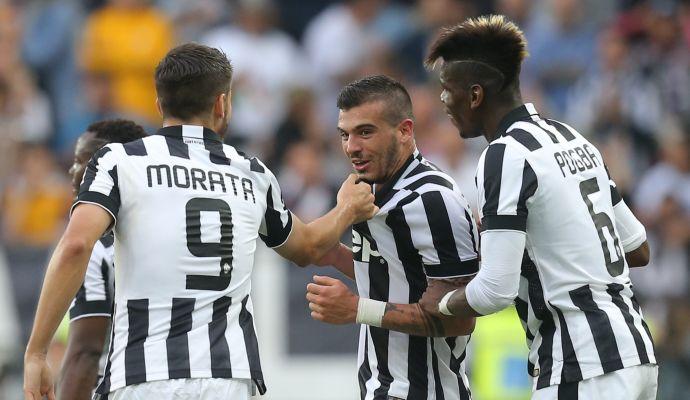
HORNCASTLE: Why Ranieri is comparing Jamie Vardy to Gabriel Batistuta
Vardy’s past working in a factory as a carbon fibre technician and playing non-league until three years ago reminded Ranieri of Moreno Torricelli. A carpenter in a furniture warehouse who used to turn out on Sundays for fourth division Carratese, a friendly against Trapattoni’s Juventus one summer changed Torricelli’s life forever. He impressed so much that they signed him on the spot. A year later he was playing in a UEFA Cup final against Borussia Dortmund and got to lift the trophy too. Other more illustrious honours - three Scudetti, two Coppe Italia and a Champions League - followed. “Vardy is England’s Torricelli,” Ranieri told La Gazzetta dello Sport.
The other player that Vardy got Ranieri thinking about was Gabriel Batistuta. “It’s amazing we’re mentioning Jamie in the same breath.” Isn’t it just. Not only for the difference in talent but to recall the stunning coincidence that Ranieri was in the dug-out at Fiorentina in 1994 when Batistuta established the Serie A record for goals in consecutive games [11]. While Batistuta’s prowess and place in history would make you nod and say: “But of course” upon learning that he set this kind of landmark, the circumstances were no less remarkable.
Fiorentina had bounced straight back to Serie A following their first relegation in 55 years. The mastermind of their promotion, Ranieri, was a specialist in it. His reputation had been built on taking Cagliari up from the third to second then the first division. That Batistuta didn’t leave is extraordinary and goes some way to explaining the affection with which he is held in Florence. After arriving to initial scepticism from Boca Juniors - Fiorentina had experienced rotten luck with foreign players in preceding years; Lubos Kubik, Marius Lacatus and Oscar Dertycia had all been flops - the 33 goals he had scored in his first couple of seasons were enough to make him one of the most wanted men in Europe.
But instead of leaving, Batistuta showed great loyalty to Fiorentina in their time of need. As did Stefan Effenberg. Serie B was not going to be easy. It’s enough to glance at the scoring charts to get an idea of the standard at the time. Batistuta struck 16 times but didn’t top them. Massimo Agostini of Ancona did. Following in his wake were Olivier Bierhoff, Batigol, Enrico Chiesa, Sandro Tovalieri and Filippo Inzaghi. A roll call of all-time greats.
Each would enter our hearts over the years. However, Batistuta began writing his legend earlier. Cadetto winners, Fiorentina were now seeking to consolidate their Serie A status and that they did so soon owed much to their striker going on a run no player had been on for three decades in Italy. Just as Vardy has brought the long forgotten achievements of Jimmy Dunne back into focus - Dunne scored in 12 consecutive games for Sheffield United between October 24, 1931 and January 1,1932 - so too did Batistuta excavate the history made by Ezio Pascutti in 1962. “I made him famous,” Batistuta joked.
A winger and champion of Italy with Bologna, Pascutti got on the scoresheet in 10 straight games. Capped 17 times for his country, his career ended prematurely through injury at 28. After his playing days were over he scouted for Carlo Mazzone for a while. Then tried his hand at coaching, taking charge of a little known team by the name of Sassuolo. In his late 50s when Batistuta was bearing down on his record, Pascutti working in insurance at the time. “Until the other day I was the only one who remembered it,” he said. “Then Batistuta started to score and all of a sudden out of nowhere I was getting calls from journalist. It’s nice to be rediscovered.”
A record that stood alone and unthreatened for 32 years was finally matched on November 20, 1994 with a brace in a 5-2 win away at Napoli and as the home fans left after the full-time whistle, the travelling support stayed back in their thousands to serenade their No.9 with chants of “Batigol.” It reduced him to tears. A week later the record finally fell at the Luigi Ferraris where Batistuta once again struck from the dischetto [penalty spot]. “I would have preferred to do it without the help of a penalty,” he said.
Of the 13 goals Batistuta scored in this run - all of which were celebrated not with the mitraglia but with one arm resting on the corner flag and another on his hip - five were from the spot. This cheapened it in the eyes of some columnists like La Repubblica’s Gianni Mura. Not one of Pascutti’s goals had been penalties. His had also come in the catenaccio era when Nereo Rocco was at Milan and Helenio Herrera at Inter. Batistuta’s came in an age when Arrigo Sacchi and Zdenek Zeman had affected a change in mentality. The goals-per-game average in Serie A was 1.92 when Sacchi was appointed coach of Milan in 1987,. By the season of Batistuta’s record it had risen to 2.52.
That, however, should by no means diminish his feat. Batistuta was playing during a period when Serie A was arguably the more competitive league the world has ever been. The depth was astounding and even if more goals were being scored it remained the most tactically sophisticated. Breaking down opponents was like solving a complex trigonometry question and the best defenders on the planet more or less all played in Serie A. Batistuta’s streak included goals against `keepers like Walter Zenga and Luca Marchegiani and centre-backs like Beppe Bergomi, Fabio Cannavaro, Pietro Vierchowod and Gianluca Signorini.
He finished the season as Capocannoniere with 26 goals. A couple of years earlier Beppe Signori had also posted that tally to top the scoring charts, but up until then no striker since Sergio Brighenti for Sampdoria in 1961 had scored so many goals in a single season in Serie A. What Signori and Batistuta were doing was incredible. Reflecting on his record, Batigol said: “Maybe in 30 years you will come and find me on my ranch in Reconquista because there’ll be a new Batistuta looking to break it.” If there is, he’ll probably be coached by Ranieri.

